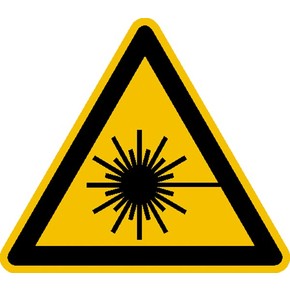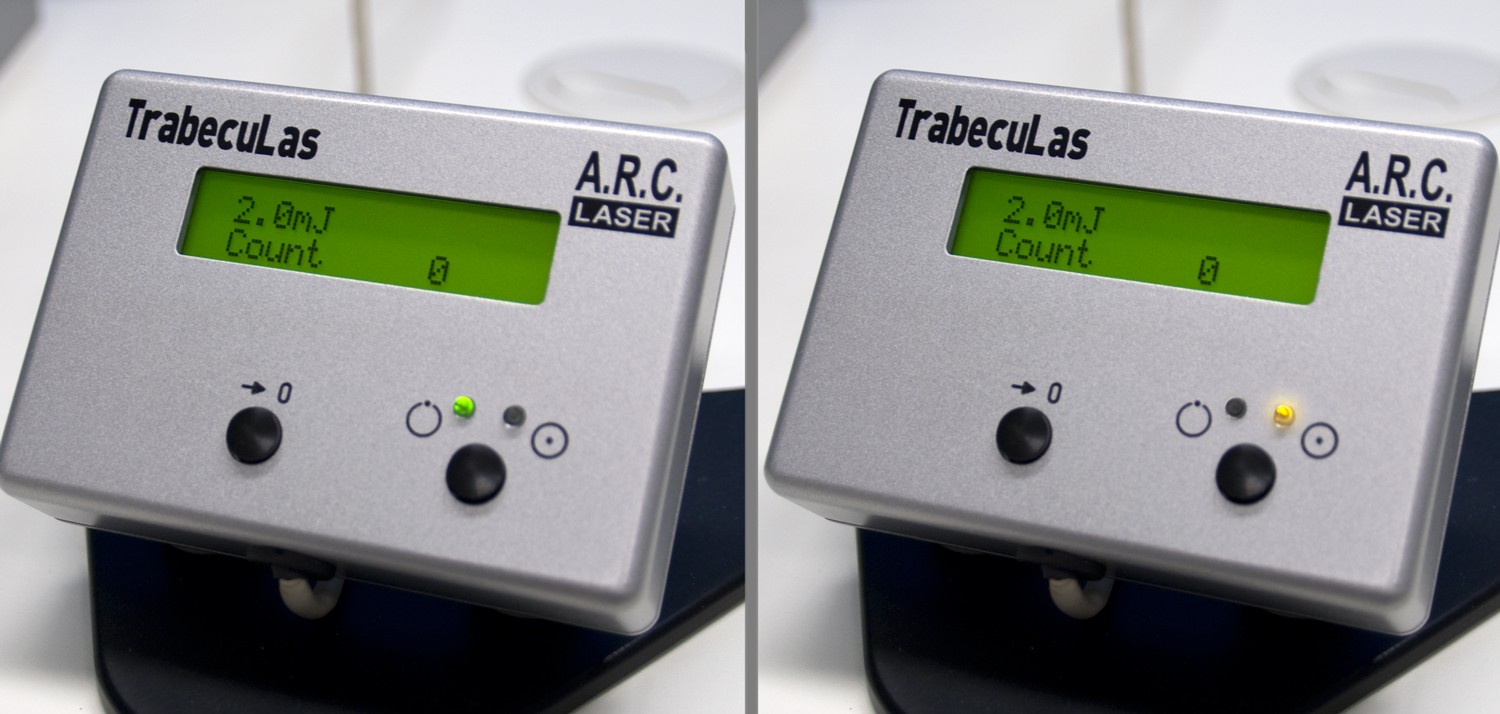Arclaser.de

Application manual for the Trabeculas-Laser
532 nm wavelength

Bessemerstr. 1490411 NürnbergTel.: +49(0)911.21779-0
Fax: +49(0)911.21779-99
For your own safety follow all
guidelines for handling the
equipment and follow the safety
instructions in this manual.
2010 A.R.C. Laser GmbH all rights reserved. Names other here named carrier companies or products are trademarks theirs respective holder of rights.
Every endeavour has been made at guarantee, that all performed informations are accurate in this manual. A.R.C. Laser assume yet no warranty for the trueness of the content in this handbook.
November 2010
1) Laser safety.4
Safety instructions.5
2) Basics of laser application.6
Indications / Contraindications.7
Application principle.9
Treatment principle.9
Pre-treatment tests.10
Behaviour in case of a system error.10
Methods in case of unwanted effects.11
Treatment related issues.11

Laser safety
Laser light emitted by the Trabeculas laser can cause severe damage to the patient as well as to the user and third persons accompanying the laser use. The Trabeculas laser is classified in the laser class IIIB. This means that the radiation can cause damage when it is directly applied to any tissue and also if the radiation is scattered or reflected.
The Trabeculas laser light is intense and efficient to disrupt or vaporize tissue. The most serious injuries occur, when laser light is exposed to the eye. Even low laser energy is able to damage the retina of the eye, which is not revers-ible. This may cause permanent blindness. The danger is dependent on the wavelength of the radiation and the dose (energy density per time).
Laser light in the wavelength range between 400 and 1400 nm is the most dangerous for the eye. It penetrates through the aqueous cornea, the anterior chamber, the lens and the posterior chamber and reaches the retina with only little or nearly no absorption.
The cornea as well as the anterior chamber, the lens and the posterior cham-ber of the eye contain mainly water. The other tissue components (mainly col-lagen), play a minor role for the laser tissue interaction. Between 400 and 1400 nm wavelength water has a very low absorption, therefore the laser light is transmitted very well and nearly the full energy reaches the retina, where it is absorbed by the blood and the retinal pigment epithelium.
The Trabeculas laser emits visible laser light of 532 nm wavelength, therefore it is absolutely necessary to wear eye safety glasses when using the Trabecu-las laser system. The surgeons, looking through the slit lamp, are protected by the eye protection filter, which is built in the slit lamp. They can work without eye googles. With its intensity (short pulsed radiation), the Trabeculas laser radiation can also do harm to skin or other tissue. The radiation can light up inflammable material.


To avoid any injuries and to use the Trabeculas laser safely it is important to follow the laser safety guidelines:
1. Any user of the Trabeculas laser system has to be trained by A.R.C. au-
thorized personal or by someone trained by A.R.C. authorized personal.
2. The room (area), where the laser system is used has to be signed with the
laser warning symbols in a way that everyone can easily see that there is a laser area, which should not be entered without the adequate protection while the laser is in use.
3. Do not use the system whenever you are not sure that every component
works in the dedicated way. Keep an eye on the beam delivery: The spot shown by the aiming beam should always be round and defined, no scat-tering should occur. You may test this, by using a light paper and holding this at the patients eye position (you have to put the laser on Ready mode, the laser mirror built in the slit lamp has to be in place).
4. By pushing the black button, the laser
switches from "Standby" mode (green LED) into "Ready" mode (orange LED on). This process takes about 5 s. Every person within the area where orange Ready-LEDradiation from the laser can occur (laser treatment area/ laser room) has to wear a laser safety goggle which is suitable to protect the eyes from Trabeculas laser radiation.
5. The laser has to be used only for the defined application; never irradiate
any other material/ tissue beside the intended use.
6. Special care should be taken to avoid irradiating reflecting materials. Re-
flected laser radiation can cause the same harm than direct application.
7. Switch off the Ready mode of the laser when the laser is not in use; e.g.
during breaks or at the end of the treatment.
Basics of laser application
The intended effect of the laser application is based on the interaction of the light with the tissue components. The laser light is absorbed or scattered or reflected by the tissue. Air and water have only little influence on the Trabecu-las radiation and therefore the interaction between air and water and the Tra-beculas radiation can be neglected.
Reflection plays a major role with metal, glass and other visually reflecting surfaces.
When we apply the Trabeculas radiation to tissue the reflection can be high. When the radiation is scattered in the tissue, it does not influence the absorp-tion. Absorption is mainly responsible for the efficiency of the laser radiation.
Absorption means, that the Trabeculas laser light is transferred to the tissue components, where it can cause the desired effects (pigment destruction/ bio-reaction).
Indications / Contraindications
Glaucoma treatment
Treatment of patients suffering from •
Glaucoma, which is not caused by
open angle glaucoma:
an elevation of intra ocular pres
Non responding to medical treat- sure
Anterior chamber, which is shallow
Allergies to medication
in a way, that via gonioscope there
is no direct view to the trabecular
Non efficient control of the intra
ocular pressure by medication
Closed angle glaucoma
Necessity but contraindicated for • Disability of the patient to sit in
glaucoma surgery (e.g. no anes-
front of the slit lamp, open the eye
and keep the position and the eye
Demand for reducing the amount
open for minimum of 2 minutes
of glaucoma medication
Improving quality of life in glauc-oma patients


For treating the chamber angle of the patient with the Trabeculas laser, a go-nioscope directing the laser beam to the chamber angle of the patients eye is necessary.
Gonioscopes which can be used are e.g.:
- 3 Mirror Goldmann contact lens (WE 01242)
- G3 Gonio Laser lens (WE 01339)
Goniscopes contain a mirror which reflects the laser beam as well as the im-age the ophthalmologist can see and make the chamber angle visible.
Using a gonioscope on the cornea, some local anesthetics is advised.
The trabecular meshwork in front of Schlemms canal is irradiated with non overlapping pulses.
The wavelength of 532 nm is strongly absorbed by pigment cells. Selective destroying of pigment cells in the trabecular meshwork lowers the intra ocular pressure. Surrounding tissue is not effected, as the pulse length of the laser is too short to cause any remarkable heat transfer. An additional effect lowering the intra ocular pressure is created by improving the permeability of Sch-lemms canal1.
1Trabecular meshwork endothelial cells (TMEs) increase the permeability of
Schlemm s canal endothelial cells (SCEs) by actively releasing ligands that modulate the barrier properties of SCEs.
(Literature: A new insight into the cellular regulation of aqueous outflow: how trabecu-
lar meshwork endothelial cells drive a mechanism that regulates the permeability of
Schlemm's canal endothelial cells. J A Alvarado, R G Alvarado, R F Yeh, L Franse-Car-
man, G R Marcellino et al. Br J Ophthalmol. 2005;89:1500-5)
• Starting with low energy (depending on the grade of pigmentation) around
• Increasing the energy stepwise until structural changes/ bubble formation is
• Decreasing the energy one step or better keeping this energy level
• Treatment with around 50 spots on 180° of the chamber angle or better
treatment of 360° with around 100 spots
It is possible to repeat the treatment after some time has passed.
• 1 hour before treatment: Pilocarpin 1% eye drops 1x
• ½ hour before treatment: Voltaren eye drops 3x
• After laser treatment: Iopidine eye drops 1x or 1 Glaupax pill 250mg
• In case of elevated pressure >30mmHg: e.g. Azopt or Alphagan or

The Trabeculas laser does an automatic internal testing on the energy output before the device can be used. The spot shown by the aiming beam should al-ways be round and defined, no scattering should occur. If no aiming beam is visible, please check if the laser mirror for the laser coupling is in place (see picture below). The laser mirror can be moved to the side and for using the laser it has to be moved in, to couple the laser coaxial into the slit lamp.
Behavior in case of a system error
In case of any failure in the energy generation of the laser, the energy which is delivered to the patient decreases. Exceeding energy cannot occur, as the energy delivered for the flash lamp pumping the YAG rod is limited. Less en-ergy than expected results in less effect. Energy variations within ± 20% are normal and within the approval tolerances and have no effect on the treat-ment success. Energy deviations of more than ± 20% are not tolerated by the system; an automatic energy measurement detects the deviation and stops
the system. If the system stop occurs because of changing conditions (e.g. room temperature), a restart may help. If a restart does not help and the er-ror message still occurs the treatment has to be stopped and the user has to follow the instructions given in the system manual. In case of any insecurity or questions please contact your local A.R.C. Laser representative.
Methods in case of unwanted effects
The application of laser light can cause vaporization if the energy density is high enough. This may result in unwanted tissue fragmentation (defects to the trabecular meshwork followed by scar formation). Continuation of the treatment should be done with lower energy settings.
Treatment related issues
As a result of the treatment, even without visible changes in the anterior chamber, the intra ocular pressure may increase temporarily after the SLT laser application. An increased intra ocular pressure within the first 12 hours after the treatment may occur. The application of laser light to the trabecular meshwork may cause some inflammatory effect as a result of the energy de-position.
To protect patients from increased intra ocular pressure post op, pressure re-ducing medication should be administered precautionary.
All personal in the treatment room have to wear eye protection googles, this may lead to decreased vision regarding contrast and color. The eye protection filer in the slit lamp protects the surgeon, who is not wearing googles.
Source: http://www.arclaser.de/files/ARCLaser/Uploads/pdf/Appl_Manual_Trabeculas_e_new.pdf
Social network wants to sequence your gut : Nature News Published online 8 September 2011 Nature doi:10.1038/news.2011.523 Social network wants to sequence your gut MyMicrobes project will gather DNA data from online community. Nicola Jones The non-profit programme MyMicrobes, launchedtoday, is inviting people to have their gut bacteriasequenced for about €1,500 (US$2,100). Acting asboth social network and DNA database, the websiteoffers a place for people to share diet tips, storiesand gastrointestinal woes with one another. Inexchange, researchers hope to gather a wealth ofdata about the bacteria living in people's guts.
Beth D. Darnall, PhD From the Department ofAnesthesiology and PerioperativeMedicine, Oregon Health and Science University, Portland, Oregon. All correspondence and requests forreprints should be addressed to Beth Self-Delivered Home-Based Mirror Darnall, PhD, Department ofAnesthesiology and Perioperative Therapy for Lower Limb Phantom Medicine, Oregon Health and ScienceUniversity, 3181 Sam Jackson Park















